The Argiope Aurantia or black and yellow garden spider appears in every US state and in many other countries around the world. It is characterized by its black and yellow abdomen and a beautifully patterned web. Argiopes are Orb Weavers, but due to their differences from other Orb Weavers, they are often put into their own group.
Argiope Spider Description
The Black & Yellow Argiope is very easy to identify, as it looks completely different from any other spider. The cephalothorax always has a light gray, white or silvery shade to it. The abdomen is nearly twice the size and very oblong, with a wide black area running down the center and the sides covered with yellow patches. The long, thinner legs will be orange (Dark Yellow) close to the body with black becoming more prominent out towards the ends. Apart from its colors, it is very similar to the Argiope trifasciata or banded garden spider and the silver garden spider (Argiope argentata).
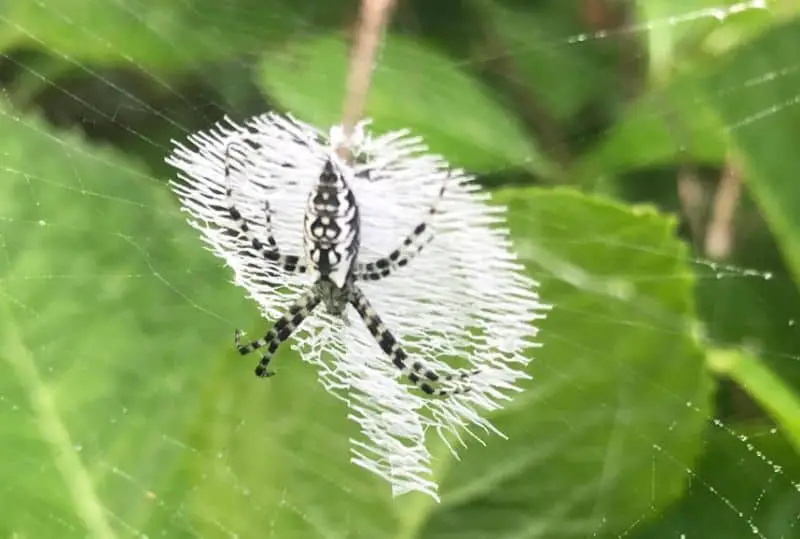
Argiope Aurantia Quick Facts
Abdomen – Large (more than double the cephalothorax) and oblong shaped. Usually black with white and yellow patterns.
Cephalothorax – White (or light Gray) and slightly dull and fuzzy looking.
Female Size – The body of the female Argiope can grow to be a little larger than one inch (25 mm). Including the legs, they can grow to over three inches, making them one of the largest spiders in Michigan.
Male Size – Much smaller than the female. Male Yellow Garden spiders are typically only 1/4 inches.
Argiope Aurantia Web
Like other Orb Weavers, the Argiopes spin large round webs for catching flying insects. However, the one way you can tell an Argiope’s web from any other is the thick zigzag pattern towards the center of the web. It is believed that is special decoration of the web should make the spider appear larger and more dangerous to predators.
Argiope Spider Bite
The Argiope bite is not dangerous to humans. The worst bites will cause some mild localized pain, itchiness, and swelling that will fade in a few days. Most bites will not even be that bad.
Distribution of the black and yellow garden spider in the USA
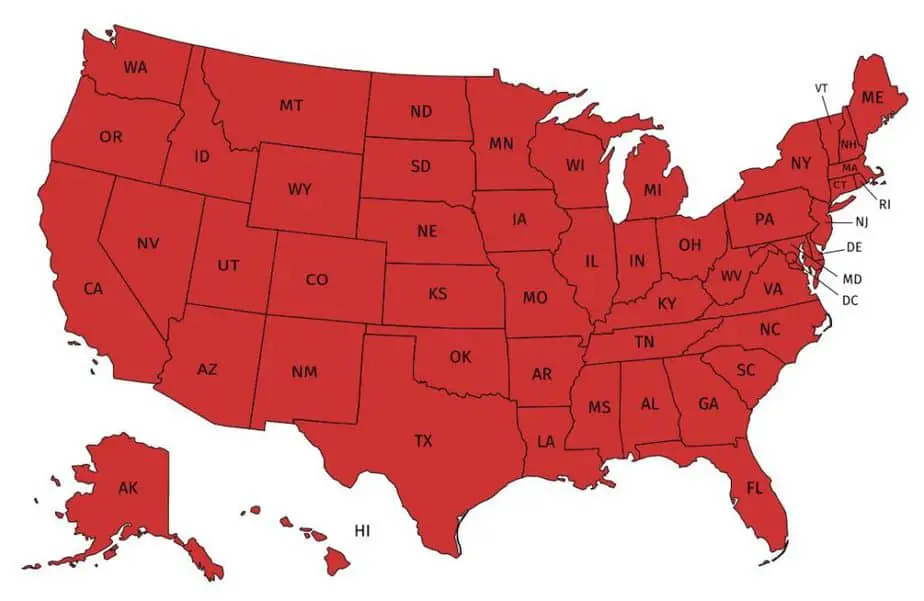
The black and yellow garden spider can be found in every US state – Alabama, Alaska, Arizona, Arkansas, California, Colorado, Connecticut, Delaware, Florida, Georgia, Hawaii, Idaho, Illinois, Indiana, Iowa, Kansas, Kentucky, Louisiana, Maine, Maryland, Massachusetts, Michigan, Minnesota, Mississippi, Missouri, Montana, Nebraska, Nevada, New Hampshire, New Jersey, New Mexico, New York, North Carolina, North Dakota, Ohio, Oklahoma, Oregon, Pennsylvania, Rhode Island, South Carolina, South Dakota, Tennessee, Texas, Utah, Vermont, Virginia, Washington, West Virginia, Wisconsin, Wyoming
Argiope aurantia Spider Pictures
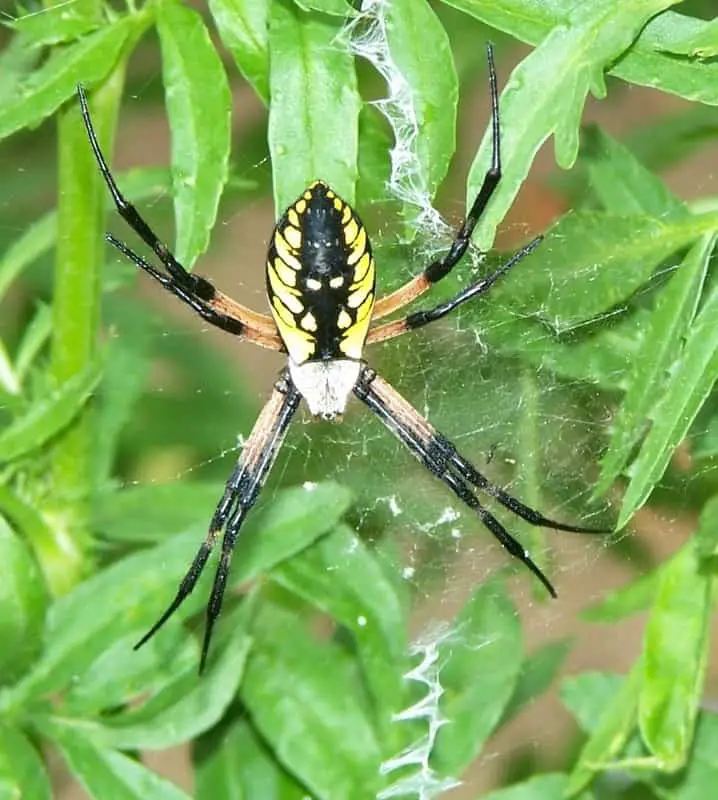
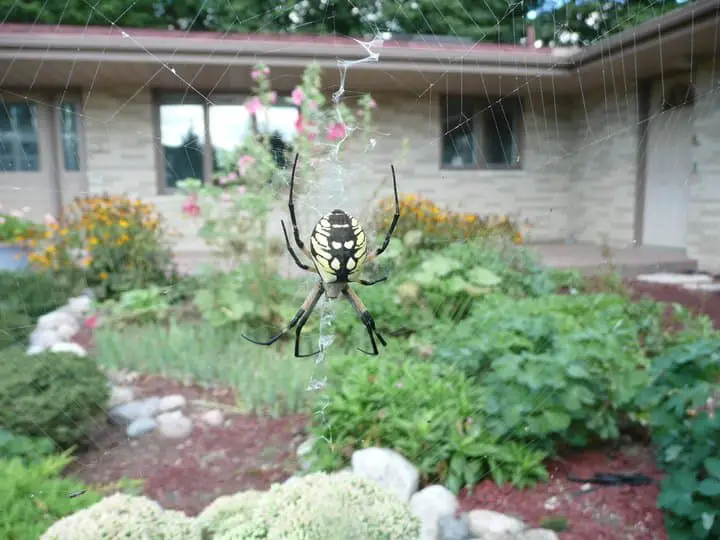
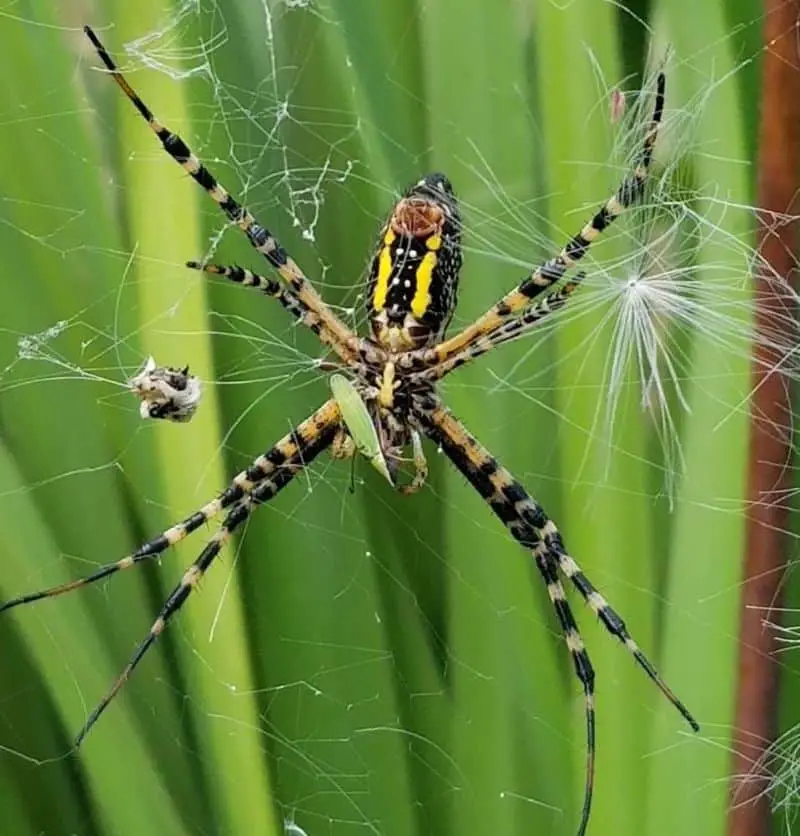
Argiope Aurantia Scientific Classification
- Kingdom: Animalia
- Phylum: Arthropoda
- Subphylum: Chelicerata
- Class: Arachnida
- Order: Araneae
- Infraorder: Araneomorphae
- Family: Aranidae
- Genus: Argiope
- Species: Argiope Aurantia
Other common names
Black and yellow garden spider, yellow garden spider, golden garden spider, writing spider, zigzag spider, hay spider, corn spider, McKinley spider.
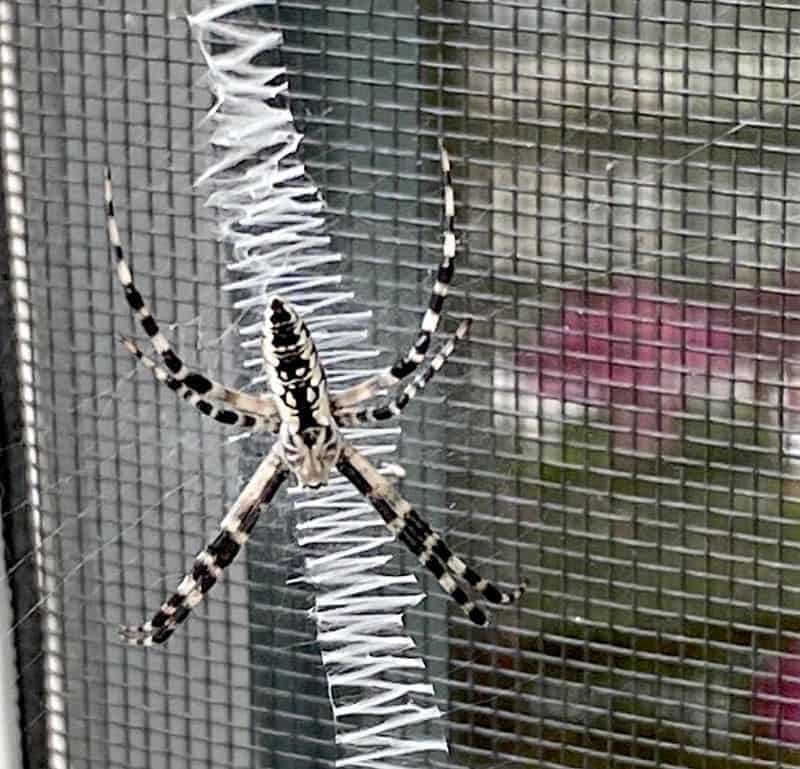

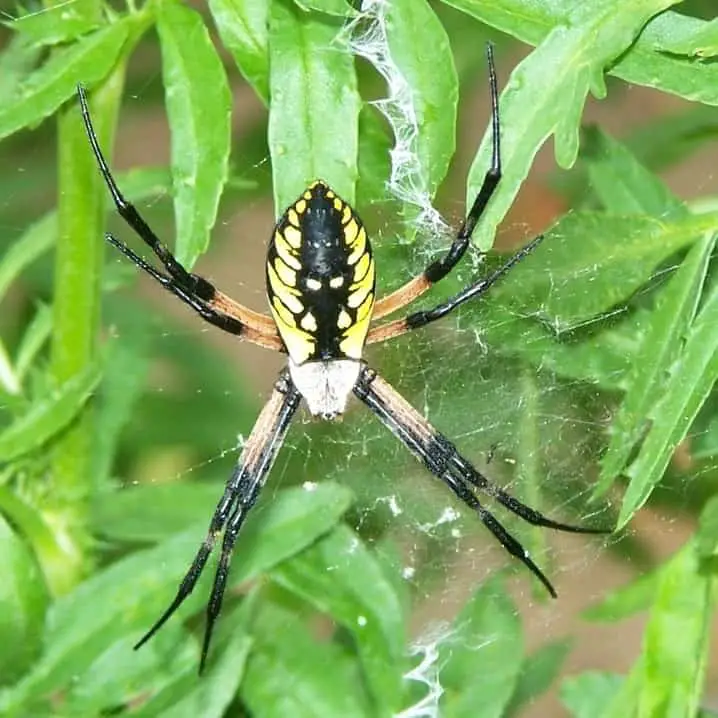
Here in the Upstate part of South Carolina (northwest corner), we call this arigope aurantia the “zipper spider” because of the thick zig-zag appearance of their webs. Gorgeous!!
Folks here in Alabama call it a banana spider for whatever reasons. Lol I’m originally from Michigan. I’ve never seen them til I came to Alabama. And they’re larger than 3 inches
Along the gulf states there is another species of spider they call banana spiders. They are yellow but definitely look more banana-like. I’m from Florida and they are everywhere in heavily wooded or swampy areas.
Pic related
Hello Devin, yes, this is a golden-silk orb weaver, which is also called banana spider. Their scientific name is Trichonephila clavipes. Here is more information and more pictures about them: https://usaspiders.com/trichonephila-clavipes-banana-spider/
Did you take this great shot and may we use it on our website?
I’m from Alabama and while a lot of people call them that for lack of knowing their actual name, I don’t call them that. I call them God’s reminder that fear is still a very real concept.
We have one of these that has taken residence on our front porch. How do we move it without harm?
— gently and slowly cup the spider with both hands – no sudden or rapid movements. It will walk onto your hands and then you can slowly move it to a new location. Do not completely enclose or trap her. You aren’t going to get bit unless you squeeze or trap her – even if you get bit, it’s no biggie. Don’t be all jumpy and she will go along with the transfer.
I have now seen my first of this species and am very happy to know that I dont have to worry about its bite. The coloring is beautiful. Which made it easy to find. I’m not going to bother it and leave it alone now knowing it’s not poisonous. Thanks for your great information. Really helped!
Nope
An urban example in Southern Virginia.
We have had a resident Argiope since mid-August. In early September she put up an egg sac right outside a window so we have a great view. Readings indicated that she would die soon after but she hung in there. One day we noticed she was gone; we mourned; she returned a couple days later; jubilation. (We really like her.) A week ago, she was gone again. And today, she is back. (The yellow markings match up exactly.) Two questions: Why is she still alive after putting up the egg sac? What gives with the leaving and coming back? Thanks for thoughts.
Wow. Trying to over my phobia with knowledge. Lol. Just noticed one this morning under eave of carport. Beautiful web. Have it on security camera so will be following close from a distance, & take pics. Gotta love retirement. ♡
Would love updates on your orb weaver
Sorry for the horribly late reply – just stumbled on this thread. If your girl was still eating, then she MAY have been putting up additional egg sacs in “secret” places. I have seen multiple sacs not always associated with the main web.
Found this in my backyard on my fence, not sure what it is…
Hello Walter, this is the web of an Argiope orb weaver. They are also called zig-zag spiders because of the stabilimenta in their webs. The spider in the picture is most likely Argiope aurantia. Here is an overview of the most common Argiope species in the U.S.: https://usaspiders.com/argiope/
I have never seen a web like this before
Hello Leila, this is the web of an Argiope orb weaver. They are also called zig-zag spiders because of the stabilimenta in their webs. The spider in the picture is most likely Argiope aurantia. Here is an overview of the most common Argiope species in the U.S.: https://usaspiders.com/argiope/
Found this guy{probably girl} on a friend’s tire pile. This is in Pine City, Minnesota. My friend lives on a horse/goat/pig farm if relevant. I don’t really have much description of it more than the pictures can show. I didn’t want to get much closer.
Hello AmberLynn, thanks for uploading this picture. This is a black and yellow garden spider, or zigzag spider (Argiope aurantia). It’s not medically significant. You can read more about them here: https://usaspiders.com/argiope-aurantia-yellow-garden-spider/
This spider was outside in a huge web on the side of my house. The web has braided parts to it. I kept knocking the web down and by the next day it was back. The spiders legs were pink on the bottom.
Hello Kris, this is a black and yellow garden spider (Argiope aurantia) – an orb weaving spider. It’s absolutely not medically significant. There isn’t really any need to kill these spiders with a spra. They can be safely picked up with a glass and a piece of paper or cardboard and relocated. Here is more information about them: https://usaspiders.com/argiope-argentata-silver-garden-spider/
Keep knocking down web. It keeps rebuilding it same place.
Hello Andrea, thanks for uploading this photo. This is a black and yellow garden spider (Argiope aurantia). It’s not a medically significant spider and great to have around the home as they will catch small flying pests with their webs. They rebuild their web daily. You can remove her safely with a cup and a piece of cardboard and relocate her. Here is more information about these spiders: https://usaspiders.com/argiope-aurantia-yellow-garden-spider/
I am not a fan of spiders although I’m trying to become more comfortable with them. Here is a photo of my friend in the garden, who i check on every day and am happy to see her. I found this page when I was trying to find out what her life expectancy is. Winter is only 3 months away…
Found this outside my apartment when I got home. Subsequently wanted to burn my apartment down. Should I be worried about it?
I am in Austin, TX
Hello IMR, thanks for getting in touch! No need to burn the apartment down 🙂 this lady may look scary, but is absolutely harmless. It’s a black and yellow garden spider (Argiope aurantia), some type of orb weaver: https://usaspiders.com/argiope-aurantia-yellow-garden-spider/
It spins orb-shaped webs to catch its prey – mostly flying insects and is therefore quite beneficial to have around.
Thank you for the information USA Spiders! I was worried I’d have to file a renter’s insurance claim. 😉
Leaving her be as she’s not posing any harm. Thank you for the information!
-IMR
Hi, I found this lovely lady in Northern IL. I can’t say that I’ve ever seen the black & yellow garden spider before.
I live near Tulsa, Oklahoma and found this spider on my front porch (North side of the house). It’s created a web from my siding to the chairs and cathouse and has caught at least 1 cicada and a grasshopper. There’s also a brownish-orange substance that has dripped down from each victim, similar in looks to spray foam insulation. My wife is deathly afraid of spiders, but I like to think of it as my pet. The web has long shoots attaching itself to the furniture and is not particularly round, but it has been effective. Any ideas?
Hello Scott, thanks for reaching out! This spider is absolutely harmless and makes a great pet. I will also get rid of annoying flying insects with its web. This is a black and yellow garden spider (Argiope aurantia). You can find more information and pictures here: https://usaspiders.com/argiope-aurantia-yellow-garden-spider/
Along the gulf states there is another species of spider they call banana spiders. They are yellow but definitely look more banana-like. I’m from Florida and they are everywhere in heavily wooded or swampy areas.
Pic related
What is this guy? Living in maine this was in my front yard
Hi Aric, this is a female black and yellow garden spider (Argiope aurantia). It’s not medically significant and great to have around as it catches flying pests with its web. This one looks gravid and will likely create an eggsac in the coming days. You can read more about them here: https://usaspiders.com/argiope-aurantia-yellow-garden-spider/
I recently had to re-locate one of these golden orb weavers from my vehicle. She settled easily and had a new web on my garage within hours. I also tried to re-locate her eggsac (which had been formed less than one week ago) but for whatever reason *ahem*… never mind my screaming and flinging it then finding it and tried unsuccessfully to gently toss it into her web… it landed in the garage in a pile of junk. Will it hatch okay there if left undisturbed? This is late August in south Texas.
Thank you
Hello Jennifer, thanks for getting in touch! The spiderlings in the eggsac could also develop outside the web if it is not disturbed by predators such as ants or other animals.
This is a big spider as it’s about 3 1/2″ or more from tip to tip of the legs. I was told that it is a banana spider although the abdomen is different. This one is big enough to take care of some big bugs, yea!!
I forgot to tell where this beautiful spider is. It’s living on the side of my shed in Aiken, SC. Here is another photo that shows its size.
Hi Rick, thanks for getting in touch and for sharing these great shots! This is a black and yellow garden spider (Argiope aurantia). It is also called zigzag spider because of the zigzag shaped stabilimenta that it adds to its webs. You can read more about them here: https://usaspiders.com/argiope-aurantia-yellow-garden-spider/
Will she die with the first frost or will she survive inside?
Can I transfer her to my unused Butterfly enclosure & feed her flies after she builds a web?
Sounds crazy but it’s a shame to see her gone now that I’m attached to her.
Thanks
Found this outside my door. Wondering if it’s safe to leave there or not. Near Evansville Indiana
Hello Dennis, thanks for getting in touch and for sharing this great shot! This is a black and yellow garden spider (Argiope aurantia). It’s not medically significant and safe to have around the house for free pest control. You can read more about them here: https://usaspiders.com/argiope-aurantia-yellow-garden-spider/
This spider Has been living in our garden for about six weeks. We’d like to know what kind of spider it is.
Hi Molly, this beauty is a female black and yellow garden spider (Argiope aurantia): https://usaspiders.com/argiope-aurantia-yellow-garden-spider/
Do you know what kind and is this spider poisonous? Thank you
Hello Regina, thanks for getting in touch! This is a black and yellow garden spider (Argiope aurantia): https://usaspiders.com/argiope-aurantia-yellow-garden-spider/
As almost all spiders, they are venomous but not medically significant. They are very hesitant to bite and in the rare cases in which a bite occurs, symptoms are generally milder than a bee sting.
Hi! I’m a preschool teacher in North Dakota and we have y zigzag spider outside of our classroom.
I was curious how active they are? Yesterday she was super busy spinning her web, but today she hasn’t moved in about 6 hours. I’m not super familiar with spider behavior so I don’t know if they typically are pretty chill or if I should be worried. 🙁
(Sorry the photos not great, it’s taken through a window. If this isn’t the right species can someone let me know what it is?)
Female with freshly laid egg sack. Please identify. This is a pretty big Alabama spider, almost the size of my palm! Also, are the tiny “bubbles” in the sack individual eggs? About what percentage will hatch? Thank you for any knowledge you can share.
Hello Dawn, this is a female black and yellow garden spider (Argiope aurantia). Depending on what time they will hatch and where the egg sac is stored during the cold months, the majority of the spiders may hatch from the eggs. They actually usually hatch before winter but don’t leave the egg sac until spring comes. By then, not all spiderlings may still be alive: https://usaspiders.com/argiope-aurantia-yellow-garden-spider/
Thank you! I really enjoy your site. It’s the most informative spider page I’ve found.
This spider has built a web near the entrance to our barn. His web is so odd with the zigzag.
Hello Lynn, thanks for getting in touch! This is a black and yellow garden spider (Argiope aurantia). Due to their interesting web patterns, they are also called zigzag spiders. They are not medically significant and catch annoying flying insects:
https://usaspiders.com/argiope-aurantia-yellow-garden-spider/
Saw this at my Papa’s place in Kingston, OK
Hello Hailey, thanks for getting in touch! This is a black and yellow garden spider (Argiope aurantia). They spin large orb-shaped webs and catch annoying flying insects – free pest control 🙂
https://usaspiders.com/argiope-aurantia-yellow-garden-spider/
This spider was “guarding” our mailbox. Is this a young yellow garden spider? The head looks spray painted silver. Now relocated to a bush. I’ve seen many of these around NJ. I live in cape may county. I just call them “orb weavers”.
What’s going on here? Is the smaller spider a male?
Found this right next to my door.
Hello Dani, this is a juvenile female black and yellow garden spider (Argiope aurantia): https://usaspiders.com/argiope-aurantia-yellow-garden-spider/
What is this?
Hi Chris, this is garden orb weaver (genus Argiope). Most likely a juvenile black and yellow garden spider (Agriope aurantia): https://usaspiders.com/argiope-aurantia-yellow-garden-spider/
Central Coast, CA, hanging out on one of my tomato plants
Hi Dak, this is a juvenile black and yellow garden spider (Argiope aurantia): https://usaspiders.com/argiope-aurantia-yellow-garden-spider/
If you are interested in learning more about spiders in California, check out our California spider identification and information book – available as an ebook here or as a printed paperback on Amazon.
Here is the larger of the two spiders that set up shop above my front door in Blythewood, SC. Last night it caught a large flying insect and quickly immobilized it with a bite and rapid web spinning. It backed off for a minute, but when the insect started moving it ran back in and appeared to bite it again.
Hi Bryan, this is a black and yellow garden spider (Argiope aurantia) – great insect control!
https://usaspiders.com/argiope-aurantia-yellow-garden-spider/
I’m curious about this spider. Fairly large.
Hi RIchard, this is a black and yellow garden spider (Argiope aurantia): https://usaspiders.com/argiope-aurantia-yellow-garden-spider/
What is it.
Hi Richard, this is a black and yellow garden spider (Argiope aurantia): https://usaspiders.com/argiope-aurantia-yellow-garden-spider/
Terrifying orb weaver by the the garden hose !
We have 4 or 5 writing spiders (garden spiders) and about a dozen Golden Silk Orb Weavers around our house in east central Alabama. The Golden Silk orb weaver’s webs are so cool. My daughter and I sit and watch these ladies do their thing. So fun to watch. We also have no flies or mosquitoes anywhere around our house. Even with the goats and chickens and the flies they used to draw, there are basically none now. I suppose the animals and the flies they draw is why the all the orb weavers moved in. We actually started with just a couple, but they have been busy reproducing and are everywhere now. Here are a pic of one of the orb weavers compared to my daughter’s hand.
My husband found this on our fence in Northern South Carolina. Eeeek!
Hi Diane, this is a black and yellow garden spider (Argiope aurantia): https://usaspiders.com/argiope-aurantia-yellow-garden-spider/
found in oklahoma
Hi Janine, this is a black and yellow garden spider (Argiope aurantia): https://usaspiders.com/argiope-aurantia-yellow-garden-spider/
What kind of spider is this found in the back yard?
Hi Cocati, this is a black and yellow garden spider (Argiope aurantia): https://usaspiders.com/argiope-aurantia-yellow-garden-spider/
This has been hanging around my garage lately. A little over 2 1/2 inches long, including legs. Located in Hertford NC (northeastern area of state).
Hello Kathy, this is a female black and yellow garden spider (Arigope aurantia). It looks to be at the end of its lifecycle – the abdomen is shriveled. They create egg sacs in autumn and then die.
https://usaspiders.com/argiope-aurantia-yellow-garden-spider/
Identification help please
Hi CJ, this is a black and yellow garden spider (Argiope aurantia): https://usaspiders.com/argiope-aurantia-yellow-garden-spider/
We call her our Texas Spider in the Sky. My husband likes her so much he’s catching flies & wasps and throwing them her way. She is so happy! It’s too funny watching him feed her!
southwest oklahoma. this summer’s been great, there are three huge orb weavers around the house. my wife and I caught this big girl entertaining company while we were out walking. it always amazes me how teeny tiny the males are.
found this on the side of our house today! ahhh!!!
Beautiful!
I am totally in love with my Black and Yellow Argiope and watch it all day long- I have tried unsuccessfully to toss it insects- but the web it has outside it’s zig zag it very weird- asymmetrical and geometric- last night I thought he? was dying only to learn that they molt- I was so happy when he was brand new in the morning- did he eat the legs from the molt? next molt I will get a photo though not sure how to sendit- I am in Connecticut
Hi again-I know that my spider is a black and yellow Argiope and previously I wrote about how I had seen it molt- my concern now is that it is in a bad location for catching insects and I’m wondering how long it can survive without eating- I keep trying to catch insects for it but can’t seem to get them to stick in the web which is a very odd
construction- it looks healthy- any suggestions?
Finally got the camera out yesterday to snap a few spider photos. Hard to get the focus correct in the wind. Taken at Morgan Falls Overlook Park in Sandy Springs, GA. Just cropped. No image processing.